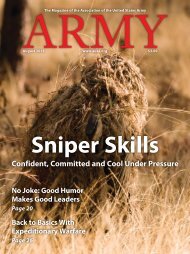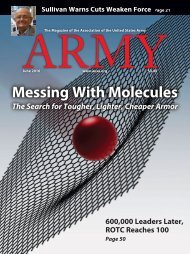All About - History - Nero - Rome's Deadliest tyrant
All About History offers a energizing and entertaining alternative to the academic style of existing titles. The key focus of All About History is to tell the wonderful, fascinating and engrossing stories that make up the world’s history.
All About History offers a energizing and entertaining alternative to the academic style of existing titles. The key focus of All About History is to tell the wonderful, fascinating and engrossing stories that make up the world’s history.
You also want an ePaper? Increase the reach of your titles
YUMPU automatically turns print PDFs into web optimized ePapers that Google loves.
Through <strong>History</strong><br />
HYGIENE PRODUCTS<br />
They say cleanliness is close to godliness, and for ancient civilisations it was so<br />
important that they developed these solutions to life’s problems<br />
50<br />
TOOTHPASTE 5000 BCE<br />
In 5000 BCE, Babylonians and Egyptians<br />
would scrub their smile with the ashes of ox<br />
hooves,eggshellsandpumice,andthetaste<br />
of this toothpaste wouldn’t improve for some<br />
time.InGreeceandRome,theypreferreda<br />
little more abrasion, adding crushed bones and<br />
oystershells.In500BCE,theChineseadded<br />
flavouring,withGinsengandherbalmints.<br />
These tooth powders eventually became a<br />
pasteinthe1800s.However,toothwhitening<br />
and decay prevention are relatively recent<br />
advancements,onlycomingintoplayin1914.<br />
SOAP 2800 BCE<br />
The first known attempt at a soap recipe comes<br />
from the Ancient Babylonians, who combined<br />
animal fats, oils and wood ash to form a detergent<br />
for their tools and possibly their clothes. The<br />
Egyptians, Greeks and Romans all developed their<br />
own cocktails of oils, salts and fats, but rather<br />
than being part of everyday skincare routines,<br />
these were mainly used medicinally. One of the<br />
foundations for modern cleanser was Aleppo Soap<br />
from the Syrian city, which was traded along the<br />
Silk Road. As it spread through Asia, the Middle<br />
East and Persia, the Europeans took notice and<br />
the Spanish Kingdom of Castile made their own<br />
version in the 12th century which<br />
is still av<br />
the expa<br />
Aleppo,<br />
Castile<br />
Soap<br />
followed.<br />
In 16th century Europe,<br />
soap was made from oils<br />
rather than animal fats<br />
One of the key ingredients<br />
of Roman toothpaste was<br />
charcoal, believed to help<br />
combat bad breath<br />
COMBS 5000 BCE<br />
It’s believed we have our ape ancestors to thank for head<br />
lice, meaning humans have been battling these<br />
bloodsuckers for hundreds of thousands of years.<br />
One of the earliest uses of combs seems to<br />
have been for this very purpose, dating back to<br />
Neolithic times. Lice combs have even been found<br />
buried in Egyptian tombs. Spartans, meanwhile,<br />
combed their hair as part of a pre-battle ritual, showing<br />
that having killer looks has always been important. With<br />
ceremonial and practical purposes, the history of combs is a long<br />
and tangled one that dates back to among the earliest tools.<br />
Early showers held the<br />
water in a vessel above<br />
the person’s head, which<br />
could be released by<br />
pulling a chain<br />
TOILET PAPER 50 BCE<br />
We’ve come a long way since the communal<br />
sponge-on-a-stick of Ancient Rome. In 50 BCE, the<br />
Chinese invented paper, and an emperor from the<br />
Song Dynasty is said to have been the first to use<br />
ordering 60 by 90-centimetre sheets to be made<br />
or his toilet time. Everyone else in the world used<br />
whatever they could get their hands on, and it<br />
might have resembled the magazine you’re<br />
olding right now. Editions of Farmers’<br />
lmanac in 1818 were even made with a hole<br />
o people could hang it in their outhouses.<br />
n fact, toilets existed long before toilet<br />
aper, which didn’t start circulating until 1857.<br />
SHOWER 1767<br />
Ancient tribes would wash away the sweat and<br />
goreofahuntwiththekindofpower<br />
Andrew<br />
Pears<br />
ENGLISH C. 1770-1845<br />
Working as a London barber, Pears<br />
developed a transparent soap fit for<br />
the delicate complexions of the upper<br />
classes. With his grandson, he formed<br />
the company A&F Pears – known for its<br />
forward-thinking advertisements. They<br />
even used their soap as a symbol for<br />
Queen Victoria’s Empire – with<br />
showerwecanonlydreamof–a<br />
waterfall – and eventually, humans<br />
tried to mimic this at home.<br />
Egyptian servants poured jugs<br />
over their masters, but the<br />
Greeks went one better and<br />
pumped water into communal<br />
shower rooms via aqueducts.<br />
The Romans continued this<br />
public bathing tradition –<br />
ordering slaves to guard their<br />
togas from thieves – and centuries<br />
later, in 1767, the first mechanical shower<br />
meantwecouldfinallywashinprivacy.<br />
a message of cleansing<br />
civilisation.<br />
In Colonial America, the<br />
toilet paper of choice was<br />
corncobs. Ouch<br />
As well as weapons, Vikings also<br />
carried combs made of antlers<br />
and bone while at sea


















